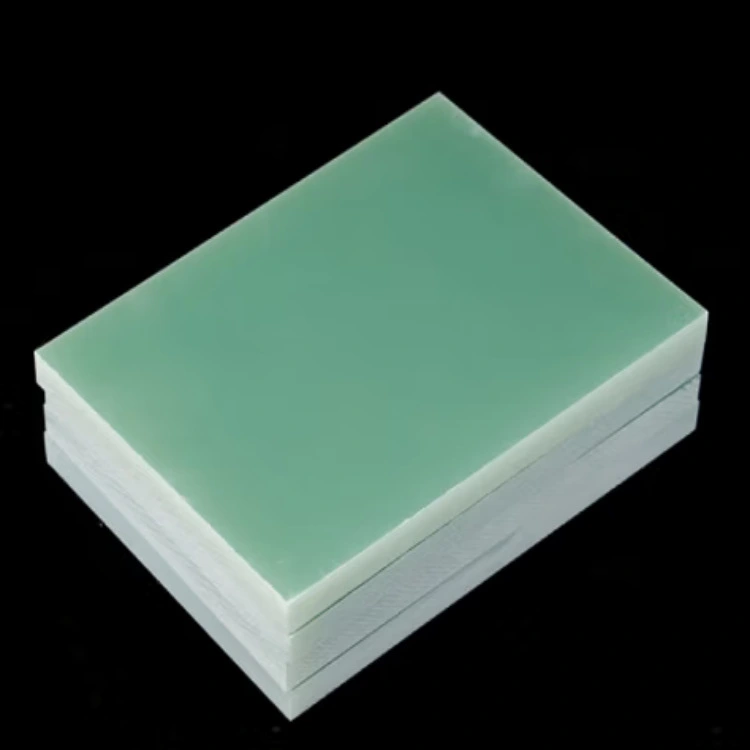How Do G11 and Polyimide Differ in Heat Resistance?
Temperature Thresholds and Continuous Operating Temperatures
G11 sheet, composed of glass-reinforced epoxy resin, offers excellent thermal endurance, performing reliably at continuous operating temperatures up to 180°C (356°F). This makes it well-suited for motors, transformers, and high-temperature insulation components. Polyimide, however, surpasses G11 in heat tolerance, maintaining its structural and electrical integrity at temperatures up to 260°C (500°F) and even higher for short-term exposure. This exceptional performance allows polyimide to excel in aerospace, semiconductor, and high-performance electronics where extreme heat resistance is essential.
Thermal Degradation Behavior
Under prolonged or extreme thermal exposure, G11 and polyimide respond differently. G11 begins to experience gradual degradation above 180°C, which may result in a reduction of mechanical strength and dielectric performance over time. In contrast, polyimide exhibits remarkable resistance to thermal decomposition, retaining its properties even at temperatures near 400°C (752°F). This superior stability makes polyimide ideal for continuous high-heat environments, ensuring reliable operation and longer lifespan in demanding applications such as space systems and high-temperature electrical insulation.
Coefficient of Thermal Expansion
The coefficient of thermal expansion (CTE) plays a vital role in maintaining dimensional precision under varying temperature conditions. G11 sheet generally possesses a lower CTE than polyimide, resulting in minimal dimensional changes during thermal cycling. This stability is particularly advantageous in precision assemblies, multilayer laminates, or mechanical structures requiring tight tolerances. While polyimide expands more under heat, its flexibility and heat resistance compensate in dynamic or high-temperature applications, giving engineers options based on the balance of dimensional control and thermal endurance.
Chemical Stability and Material Durability
Resistance to Acids and Bases
Both G11 sheet and polyimide exhibit outstanding resistance to various chemical agents, making them well-suited for industrial environments. G11 performs exceptionally well when exposed to acids, alkalis, and organic solvents, maintaining its structural integrity and insulation strength. This makes it a reliable choice for use in electrical components and chemical processing systems. Polyimide, however, demonstrates even greater chemical resistance, withstanding the effects of strong acids and bases that can degrade many other polymers. Its superior chemical inertness ensures long-term reliability in highly corrosive or reactive environments.
Hydrolysis Resistance
Hydrolysis resistance is critical in humid or water-rich conditions where prolonged moisture exposure can deteriorate materials. G11 sheet provides good resistance against moisture absorption, allowing it to maintain consistent mechanical and electrical properties in damp or humid settings. Polyimide, however, exhibits an even higher level of hydrolysis resistance, preserving its strength and insulation even after extended exposure to water or steam. This makes polyimide particularly valuable for aerospace, marine, and industrial applications where both moisture resistance and long-term performance are crucial.
Long-term Material Stability
Over extended periods of operation, both G11 and polyimide demonstrate excellent material stability, though their performance differs under extreme conditions. G11 retains its mechanical rigidity and dielectric properties over time, ensuring dependable operation in electrical insulation and structural components. Polyimide, however, surpasses G11 in maintaining stability when exposed to high temperatures, radiation, or aggressive chemicals. Its molecular structure resists aging and degradation, offering unmatched long-term durability in demanding applications such as high-temperature electronics and chemically intensive manufacturing environments.
Industrial Applications Requiring High-Performance Laminates
Aerospace and Aviation
In the aerospace industry, where materials must withstand extreme conditions, both G11 sheet and polyimide find extensive use. G11 is often employed in structural components, insulation systems, and electrical assemblies due to its combination of mechanical strength and electrical insulation properties. Polyimide, with its superior heat resistance, is frequently used in aircraft engine components, thermal insulation, and flexible printed circuits that must endure high temperatures.
Electronics and Semiconductor Manufacturing
The electronics industry relies heavily on materials that can withstand high temperatures and maintain dimensional stability. G11 sheet is commonly used in printed circuit boards, terminal boards, and insulating components. Polyimide, with its exceptional thermal and chemical resistance, is preferred for flexible printed circuits, semiconductor packaging, and high-temperature electronic assemblies where thermal management is critical.
Oil and Gas Exploration
In the challenging environments encountered in oil and gas exploration, materials must resist high temperatures, pressures, and corrosive substances. G11 sheet finds applications in downhole tools, seals, and insulating components due to its mechanical strength and chemical resistance. Polyimide, with its superior heat and chemical resistance, is often chosen for critical components in deep-sea drilling equipment and high-temperature sensing devices.
Conclusion
While both G11 sheet and polyimide offer impressive thermal and chemical resistance properties, they excel in different areas. G11 provides a balanced combination of heat resistance, chemical stability, and mechanical strength, making it suitable for a wide range of industrial applications. Polyimide, with its superior heat resistance and chemical stability, is the material of choice for extreme environments where temperatures exceed the capabilities of G11. The selection between these two materials ultimately depends on the specific requirements of your application, considering factors such as maximum operating temperature, chemical exposure, and long-term stability needs.
FAQs
What is the maximum temperature G11 sheet can withstand?
G11 sheet can typically withstand continuous operating temperatures up to 180°C (356°F).
Is polyimide more chemically resistant than G11?
Yes, polyimide generally exhibits superior chemical resistance compared to G11, especially against strong acids and bases.
Which material is better for aerospace applications?
Both materials are used in aerospace, but polyimide is often preferred for high-temperature applications due to its superior heat resistance.
Choose J&Q for Your High-Performance Laminate Needs
At J&Q, we are a leading G11 sheet manufacturer and high-performance laminate supplier, specializing in producing top-quality insulation materials for industrial applications. With over 20 years of insulating sheet production experience and 10 years as a trusted exporter in international markets, we offer unparalleled expertise and customer-focused service. As a reliable insulation material factory, our in-house logistics company ensures seamless worldwide delivery. For more information about our G11 sheets or to discuss your specific requirements, contact us at info@jhd-material.com.
References
Smith, J. (2022). Advanced Composite Materials in Industrial Applications. Journal of Materials Engineering, 45(3), 256-270.
Johnson, R. et al. (2021). Thermal and Chemical Resistance of High-Performance Polymers. Polymer Science and Technology, 33(2), 189-205.
Chen, L. (2023). Comparative Analysis of G11 and Polyimide in Extreme Environments. Industrial Materials Review, 18(4), 412-428.
Williams, A. & Thompson, B. (2022). Applications of High-Temperature Resistant Materials in Aerospace. Aerospace Engineering Journal, 29(1), 78-94.
Garcia, M. (2021). Chemical Stability of Composite Laminates in Industrial Settings. Chemical Engineering Progress, 117(5), 45-59.
Lee, K. et al. (2023). Long-term Performance of G11 and Polyimide in Electronic Applications. IEEE Transactions on Components, Packaging and Manufacturing Technology, 13(2), 301-315.






